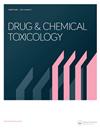暴露于利谷隆后线粒体功能障碍的起始事件是解偶联。
IF 2.1
4区 医学
Q3 CHEMISTRY, MULTIDISCIPLINARY
引用次数: 0
摘要
利谷隆(Diuron)是一种从尿素中提取的除草剂,已被证明会诱发啮齿类动物的膀胱尿道肿瘤,因此美国环境保护局(USEPA)将其定为 "已知/可能 "人类致癌物。在我们的实验室里,对 Diuron 的致癌作用模式(MoA)进行了一系列调查研究,结果一致表明 Diuron 对膀胱尿路上皮细胞具有细胞毒性作用。长期接触相对高剂量的敌草隆,会导致尿路上皮坏死、再生增生,最终发展成肿瘤。我们提出的假设是,迪优隆及其代谢物通过对线粒体造成损害来产生毒性,这种现象被称为 "有丝分裂毒性"。我们的研究重点是评估利谷隆及其代谢物如何影响从尿道和肝脏(利谷隆生物转化的主要器官)中分离出来的线粒体。在此背景下,我们介绍并讨论了从 Wistar 大鼠肝脏中分离出的线粒体的相关数据,这些线粒体在体外暴露于浓度为 0.5 至 500 µM 的敌草隆或其代谢物 3-(3,4-二氯苯胺)-1-甲脲(DCPMU)或 3,4-二氯苯胺(DCA)。研究结果表明,在 100 和 500 µM 的浓度下,受测化学物质会诱导氧化磷酸化的解偶联,线粒体膜电位的耗散和基础耗氧量就是证明。值得注意的是,在 500 µM 的浓度下,DCA 会导致线粒体肿胀,这是细胞器严重受损的形态功能指标。这些结果突出表明,鉴于迪古隆及其代谢物 DCA 和 DCPMU 会引起明显的线粒体功能障碍,因此它们被归类为对肝细胞具有有丝分裂毒性的物质。本文章由计算机程序翻译,如有差异,请以英文原文为准。
Uncoupling as initiating event in mitochondrial dysfunction after diuron exposure.
Diuron, a herbicide derived from urea, has been shown to induce urinary bladder urothelial tumors in rodents, leading the U.S. Environmental Protection Agency (USEPA) to designate it as a 'known/likely' human carcinogen. In our laboratory, a series of studies investigating the carcinogenic mode of action (MoA) of Diuron have consistently revealed its cytotoxic effects on the urinary bladder urothelium. Prolonged exposure to relatively high doses of Diuron results in urothelial necrosis, regenerative hyperplasia, and eventually, the development of tumors. The hypothesis posited is that Diuron and its metabolites exert toxicity by causing damage to mitochondria, a phenomenon referred to as mitotoxicity. Our research focuses on evaluating how Diuron and its metabolites affect mitochondria isolated from both the urothelium and the liver, the primary organ for Diuron biotransformation. In this context, we present and discuss data pertaining to mitochondria isolated from the liver of Wistar rats exposed to Diuron or its metabolites 3-(3,4-diclorofenil)-1-metilureia (DCPMU) or 3,4-dichloroaniline (DCA) at concentrations ranging from 0.5 to 500 µM in vitro. The findings indicate that, at concentrations of 100 and 500 µM, the tested chemicals induce uncoupling of oxidative phosphorylation, as evidenced by the dissipation of mitochondrial membrane potential and basal oxygen consumption. Notably, at 500 µM, DCA causes mitochondrial swelling, a morphofunctional indicator of severe organelle damage. These outcomes underscore the classification of Diuron and its metabolites, DCA and DCPMU, as mitotoxic to liver cells, given the pronounced mitochondrial dysfunction they induce.
求助全文
通过发布文献求助,成功后即可免费获取论文全文。
去求助
来源期刊

Drug and Chemical Toxicology
医学-毒理学
CiteScore
6.00
自引率
3.80%
发文量
99
审稿时长
3 months
期刊介绍:
Drug and Chemical Toxicology publishes full-length research papers, review articles and short communications that encompass a broad spectrum of toxicological data surrounding risk assessment and harmful exposure. Manuscripts are considered according to their relevance to the journal.
Topics include both descriptive and mechanics research that illustrates the risk assessment implications of exposure to toxic agents. Examples of suitable topics include toxicological studies, which are structural examinations on the effects of dose, metabolism, and statistical or mechanism-based approaches to risk assessment. New findings and methods, along with safety evaluations, are also acceptable. Special issues may be reserved to publish symposium summaries, reviews in toxicology, and overviews of the practical interpretation and application of toxicological data.
 求助内容:
求助内容: 应助结果提醒方式:
应助结果提醒方式:


